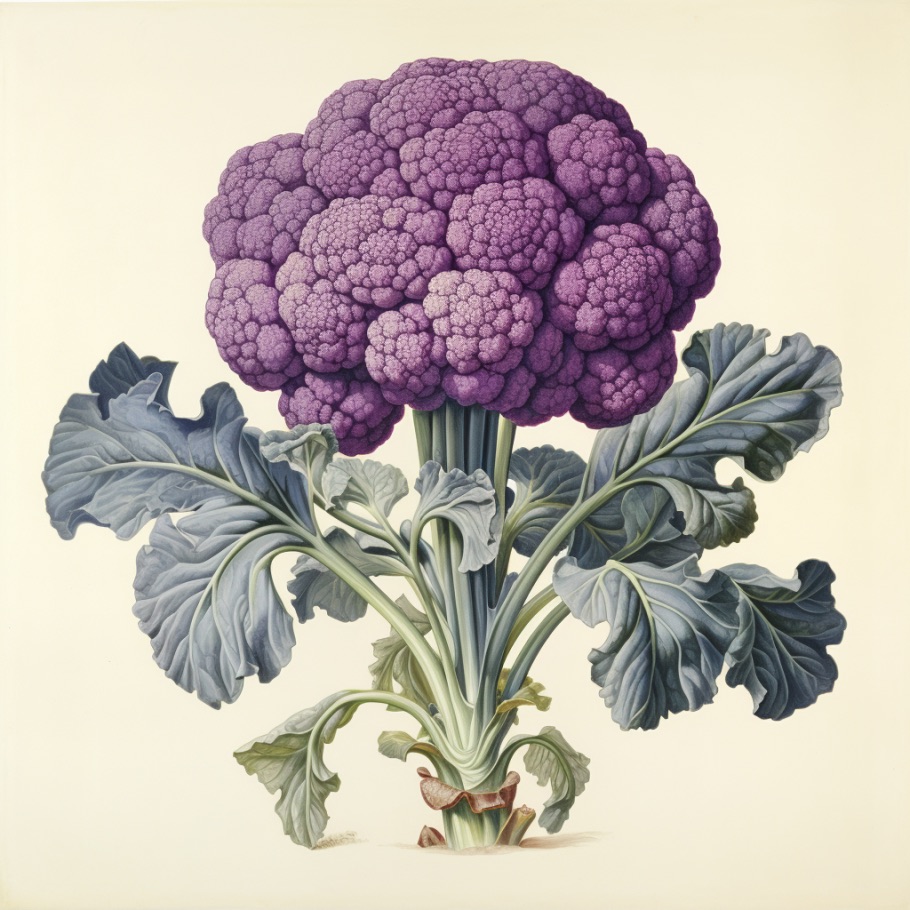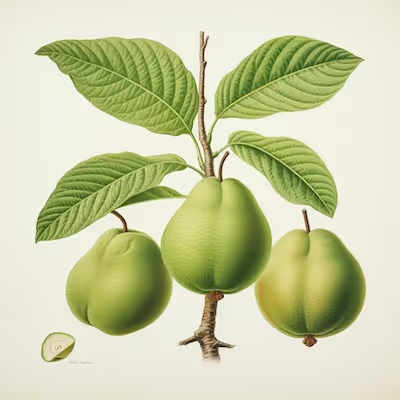Growing Purple Cauliflower for Colorful, Nutritious Harvests

Growing Purple Cauliflower
Growing purple cauliflower injects vivid color and nutritious bounty into your garden beds. Rich in anthocyanins, antioxidants linked to heart and brain health, this vibrant brassica thrives best in cool weather and fertile, well-drained soil. Learn how planting this eye-catching veggie can brighten your plate and nourish your body with every crunchy bite.
I grow purple cauliflower for the same reason chefs hoard Maldon salt. It wakes up a plate and it earns its real estate in the bed.
The heads look like amethyst geodes under leaves, and kids eat them without negotiation.
Why purple pays
Growing Purple Cauliflower taps into anthocyanins, the plant pigments that paint blueberries and red cabbage and add bitey complexity to flavor. They also handle bright sun better than white types, which means stronger color if you keep heat stress in check.
USDA FoodData Central lists about 77 percent DV vitamin C in 1 cup raw cauliflower, and purple types add extra polyphenols that white heads lack. Flavor lands sweeter in cool weather, with a mild nuttiness that roasts like a dream.
“Cauliflower is the most difficult cole crop to grow.” Cornell Cooperative Extension says it bluntly, and they are right. Get the timing and stress control right, or the plant throws buttons instead of a head.
Site and soil that set you up
Full sun is the ticket for color, 6 to 8 hours daily. Keep plants cool with mulch if your afternoons climb above 80 F or 27 C.
Aim for pH 6.2 to 7.0, rich organic matter, and steady moisture. I mix in 2 to 3 inches, or 5 to 8 cm, of compost and a balanced organic fertilizer at label rate before transplanting.
Timing by season and zone
I start seeds indoors 4 to 6 weeks before last spring frost and set transplants out 2 to 3 weeks before that frost date with row cover insurance. For fall crops, I sow 12 to 16 weeks before first frost and transplant 8 to 10 weeks before it.
Target cool finish. Heads size best with daytime temps 60 to 70 F, or 15 to 21 C, and nights cooler. Heat spikes cause ricey heads, while prolonged chill on seedlings can trigger buttoning.
Seed starting that prevents buttoning
- Use a 72-cell tray and seed 1 per cell at 0.25 inch, or 6 mm.
- Germinate at 70 to 75 F, or 21 to 24 C, with strong light from day one.
- Grow on at 60 to 65 F, or 15 to 18 C, never letting seedlings sit below 50 F or 10 C for extended periods.
- Harden 5 to 7 days outdoors, then transplant when they have 4 to 5 true leaves.
Transplant spacing and irrigation
Space 18 inches, or 45 cm, in-row and 24 to 30 inches, or 60 to 75 cm, between rows. I push a little wider in summer to cool the canopy.
Water 1 to 1.5 inches per week, or 25 to 38 mm, and use 2 to 3 inches, or 5 to 8 cm, of straw or leaf mulch. Drip irrigation avoids leaf wetness that invites disease.
Feeding for steady growth
Cauliflower likes a steady buffet, not a feast. Side-dress nitrogen 3 to 4 weeks after transplant, then again at early head formation.
I use a half cup blood meal per 10 feet, or 3 m, of row, or a light pass of calcium nitrate if tipburn shows. If you suspect boron deficiency, get a soil test first and follow local extension rates since boron can damage plants when overapplied.
Color, blanching, and leaf tying
Purple types usually skip blanching. Sun deepens the purple and improves flavor in cool weather.
During heat waves, I still pull a couple of outer leaves loosely over the head to prevent bronzing. A soft tie or a clothespin does the trick.
Varieties I trust for color and reliability
- Graffiti F1: Electric purple, dense heads, 80 to 85 days from transplant. True farmers market magnet.
- Purple Crush F1: Mid-early at 65 to 70 days, smoother heads, good heat tolerance for a purple.
- Depurple F1: 75 to 80 days, uniform curds, rich color even without leaf cover.
- Purple of Sicily (OP): 75 to 80 days, forgiving and flavorful, slightly looser curd.
- Purple Cape (winter type): For fall transplant and spring harvest where winters stay mild.
Where I buy seeds and starts
Look for reputable suppliers that list days to maturity from transplant and note heat tolerance and head uniformity. I have had consistent lots from specialty vegetable seed houses that serve market growers.
For transplants, choose short, sturdy plants with dark leaves and no visible buttons. Avoid lanky starts or anything with stressed, purpled stems from cold exposure.
Storage and postharvest
Harvest when heads are tight and even, before the surface granulates. Cut with several jacket leaves for protection.
Store at 32 F, or 0 C, with high humidity around 95 percent. With clean heads, I get 2 to 3 weeks in a perforated bag, away from apples or other ethylene sources.
Cooking without losing the purple
Steam or roast quickly to keep color. Boiling bleaches anthocyanins into the water.
A splash of lemon or vinegar keeps the hue vibrant. Alkaline water turns it gray.
Pest and disease playbook
- Caterpillars: Imported cabbageworm, looper, diamondback moth. Use floating row cover or insect netting from day one, handpick, and apply Bt kurstaki while larvae are small.
- Aphids: Blast with water, encourage syrphid flies and wasps by growing alyssum, then use insecticidal soap if needed.
- Flea beetles: Exclude with fine mesh and keep seedlings growing fast with even water and nutrition.
- Downy mildew and black rot: Improve airflow, avoid overhead watering late in the day, and rotate 3 to 4 years out of Brassicas.
- Clubroot: Raise pH toward 7 with lime, avoid moving soil on tools, and rotate long. Resistant cultivars help, but sanitation helps more.
Common problems and my fixes
- Buttoning instead of heads: Seedlings chilled, drought, or nutrient swings. Keep starts warm, fertilize lightly but consistently, and never let them wilt.
- Ricey or loose curds: Heat spikes or late harvest. Plant for a cool finish and pick early.
- Purple fading to green while cooking: High pH water. Add acid and keep cooking time short.
- Bronzed tops: Sun plus heat. Tie leaves during warm spells or increase mulching.
Yield math that pays off
I average 1 to 1.5 heads per square foot across a bed over the season by staggering sow dates. Typical head weight runs 1.5 to 2.5 pounds, or 0.7 to 1.1 kg, depending on variety and fertility.
Uniform transplant age matters. I plant blocks of 30 to 50 seedlings grown the same week, which keeps harvest tight for market or batch cooking.
Gear that makes this crop easier
- Lightweight row cover, 0.5 to 0.6 oz per square yard, or 17 to 20 g per m², for insect exclusion.
- Heavier cover, 0.9 oz per square yard, or 30 g per m², for frost protection in spring and fall.
- Drip tape with 8 to 12 inch, or 20 to 30 cm, emitter spacing for even moisture.
- Soil pH meter and a basic EC meter to stop guessing at fertility.
Science corner, in plain language
Anthocyanins like cyanidin-3-glucoside give purple cauliflower its color and act as antioxidants. Multiple academic analyses report higher total phenolics in purple cultivars than white ones, especially under cool, high-light conditions.
RHS notes that purple cauliflower usually does not require blanching, while white types do to prevent yellowing. UC ANR and the Cornell Vegetable Program both stress even growth to avoid stress-triggered defects.
USDA FoodData Central: 1 cup raw cauliflower offers about 27 calories, 2 g fiber, and roughly 77 percent daily value vitamin C. Purple types add anthocyanins found in berries and red cabbage.
Regional planting cheatsheet
- Cool-summer coastal or high elevation: Spring and summer transplants perform well, and fall plantings glow with color.
- Hot-summer inland: Aim for fall harvest. Start seed mid to late summer in the shade and transplant under row cover to dodge caterpillars.
- Mild winter regions: Try winter-type purple like Purple Cape for spring heads after overwintering.
Companions and rotation
I rotate Brassicas on a 3-year minimum to manage clubroot and black rot. Follow cauliflower with legumes or alliums, then a cover crop like oats and peas to rebuild soil.
Flowering companions such as sweet alyssum and dill recruit beneficial insects. Keep mustard cousins out of the rotation if clubroot lurks.
Market and kitchen angles
Chefs buy with their eyes. A crate of tight, neon-purple heads with long white stems sells faster than any white counterpart on my table.
Slice thick steaks, brush with olive oil and lemon, and roast at 425 F, or 220 C. The edges caramelize, the center stays tender, and the color holds with a squeeze of citrus.
Quick checklist for Growing Purple Cauliflower
- Start seed 4 to 6 weeks before last frost. Keep seedlings warm and fast-growing.
- Transplant into fertile, evenly moist soil at 18 by 24 inches, or 45 by 60 cm.
- Feed lightly but often. Side-dress at 3 to 4 weeks and at head initiation.
- Exclude pests early with row cover. Scout weekly and act before damage escalates.
- Manage heat with mulch and, if needed, leaf tying. Time crops to finish in cool weather.
- Harvest when tight. Store at 32 F or 0 C, high humidity, away from ethylene.
Trusted references I lean on
- USDA FoodData Central for nutrient data.
- Cornell Cooperative Extension Vegetable Program for timing and defect avoidance.
- UC ANR and MSU Extension for fertility, pest management, and boron cautions.
- RHS Grow Your Own guidance on blanching, spacing, and seasonal scheduling.
I have lost plantings to a single dry week and saved others with nothing more than shade cloth and a second side-dress. Purple cauliflower rewards attention with heads that stop traffic at the farm gate.
Give it timing, water, and care, and it gives you color, crunch, and a story to tell at dinner. That is a trade I make every season.
Cheatsheet: Vibrant Purple Cauliflower Growing
🌱 Varieties & Benefits
- Graffiti, Sicilian Violet, Purple Cape
- Rich in anthocyanins, boosts antioxidants by 25% over white types
- High fiber, vitamin C, K, B6
🗓️ Timing & Location
- Start indoors 6 weeks before last frost
- Transplant after soil warms to 55°F/13°C
- Full sun, 6+ hrs/day
🌾 Soil & Feeding
- Loose, fertile, pH 6.5–7.5
- Add compost or aged manure
- Mix slow-release organic fertilizer before planting
📏 Spacing & Planting
- Space 18–24 in/45–60 cm apart
- Rows 30 in/75 cm apart
- Plant deep, up to first leaf
💧 Water & Mulching
- Consistent moisture, 1–1.5 in/2.5–4 cm per week
- Mulch keeps soil cool, retains moisture
🐛 Pest & Disease Guard
- Row covers repel cabbage worms, loopers
- Hand-pick pests early morning
- Rotate crops yearly for soil health
🎨 Harvest for Color & Flavor
- Ready in 75–90 days
- Harvest heads at 6–8 in/15–20 cm wide, before florets loosen
- Color holds best in cool temps
🧰 Tools and Products You'll Need
- Purple cauliflower seeds
- Organic compost
- Balanced vegetable fertilizer
- Mulch (straw, leaves)
- Hand trowel
- Watering can or drip hose
- Row covers
- Harvest knife
🍽️ Uses & Storage
- Eat raw, roast, steam, or pickle for intense color
- Store heads up to 2 weeks at 32°F/0°C, high humidity
- Start seeds indoors 6 weeks before last frost date
- Transplant to garden after danger of frost, spacing 18–24 in/45–60 cm
- Apply compost and fertilizer at planting
- Maintain even soil moisture with mulch
- Check daily for pests, use covers as needed
- Harvest when heads reach 6–8 in/15–20 cm across
Purple Cauliflower Gardening FAQs
How Much Sunlight Does Purple Cauliflower Need?
Purple cauliflower savors a full sun affair—six hours minimum daily. Less sunlight can trigger loose, underwhelming heads. Select a garden bed basked in steady sunlight to ensure hearty, vivid crops.
What's the Ideal Soil for Growing Purple Cauliflower?
Feed your purple crop a rich, well-draining soil with a pH drifting gently between 6.0 and 7.0. Amend generously with compost or aged manure to give those luxurious florets the nutrient-rich foundation they desire.
When Should Purple Cauliflower be Planted?
For spring harvest, plant seeds indoors 4–6 weeks prior to your area's last frost date. Purple cauliflower flourishes in cool climates—seize the cool temperatures of early spring or late summer into autumn to sustain growth.
How Often Should Purple Cauliflower be Watered?
Regular hydration is key—maintain soil moisture without saturating it, typically offering your purple cauliflower about 1–1.5 inches of water weekly. Consistency wards off stress and encourages impressive heads.
What Common Issues Affect Purple Cauliflower Plants?
Vigilance counters pests such as cabbage worms and aphids—check leaves regularly and gently remove intruders. Rotate crops annually to avoid diseases like clubroot or fungal infections, preserving plant health and productivity.
When is Purple Cauliflower Ready to Harvest?
Harvest approaches once heads grow firm, compact, and radiant—typically between 60–85 days after transplanting. Cut cleanly below the head, leaving some outer leaves to protect it, then savor promptly for peak flavor and nutrition.
Growing Purple Cauliflower adds a punch of color and a dose of nutrition to any patch. These beauties aren’t fussy, but they do want rich soil, steady moisture, and a bit of patience. Protect young heads from harsh sun and keep your eyes peeled for cabbage worms. You’ll get crisp, purple florets loaded with antioxidants—good for your plate and your pride. For those looking to round out their garden with other vibrant crops, check out how to grow radicchio or explore growing broccoflowers for more color and crunch. Trust your hands, trust the earth, and purple cauliflower will reward you in spades.



